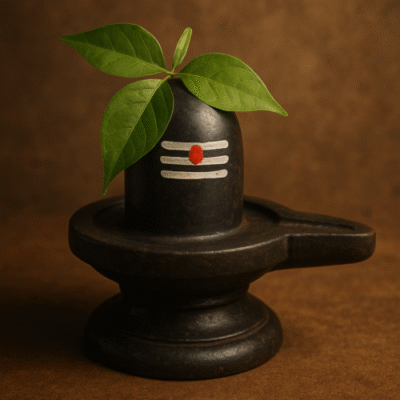🌿 Importance of Belpatra in Shiva’s Life
Belpatra (Bilva leaves) holds a sacred place in Hinduism, especially in the worship of Lord Shiva. The trifoliate leaf of the Bel tree symbolizes the Trishul (trident) of Shiva, representing his three fundamental powers — creation, preservation, and destruction. Offering Belpatra is considered to cool Lord Shiva, who holds the fierce power of destruction as part of the cosmic cycle.

🌿 Belpatra and Lord Shiva – A Deeper Understanding
🔱 Symbol of Purity and Simplicity
- Lord Shiva is known as Bholenath, the simple-hearted God who is easily pleased with even the simplest offerings made with devotion.
- Belpatra represents purity and simplicity. It grows in hard, rocky, and even barren lands, yet remains sacred — just like devotion that blooms even in difficult circumstances.
- The leaf’s structure — trifoliate (3 leaflets) — is said to represent:
- The three eyes of Shiva (Surya, Chandra, and Agni)
- The three syllables of AUM (A, U, M)
- The three worlds (Swarga – heaven, Bhumi – earth, Patal – underworld)
🌿 Mythological Significance
There are several myths associated with Belpatra and Shiva:
1️⃣ Origin of the Bel Tree:
According to Shiva Purana, the Bel tree emerged from the sweat of Goddess Lakshmi as she meditated on Mount Mandara. It is said that the tree is dear to Lord Shiva because it came from Lakshmi’s devotion.
2️⃣ The Story of a Hunter:
Once, a hunter was trapped in a forest as night fell. To protect himself, he climbed a Bel tree. To stay awake, he kept plucking its leaves and dropping them. Unknowingly, the leaves fell on a Shiva Lingam beneath the tree. The next morning, he found that his sins were forgiven and he was blessed by Lord Shiva, as the act was seen as an offering done with a pure heart.
3️⃣ The Three Leaves Symbolism:
The three parts of Belpatra represent Shiva’s three eyes, or three gunas (Sattva, Rajas, Tamas). Offering this leaf pleases Shiva as it symbolizes surrendering the mind, body, and soul.
🌿 Why Do We Offer Belpatra to Shiva?
✅ Belpatra has cooling properties, and Shiva — who drank the deadly Halahala poison during the Samudra Manthan — is offered Belpatra to soothe his throat and inner being.
✅ Offering Belpatra is said to remove negativity and sins. Even a single leaf offered with true devotion can give immense spiritual merit.
✅ The leaf’s trifoliate form is believed to neutralize doshas (defects) like Graha dosha and Pitru dosha.
✅ According to scriptures, offering Belpatra on Maha Shivaratri, Mondays, and during the month of Shravan brings health, wealth, and liberation (moksha).
🌿 How Should Belpatra Be Offered?
- Always offer fresh, unbroken, and clean Belpatra.
- The leaf’s smooth side (shiny side) should face upwards on the Shiva Lingam.
- It’s auspicious if the leaf has its stalk intact, as it represents wholeness.
✨ Stories and Beliefs
✅ Daksha’s Yagna & Belpatra
After Sati immolated herself at Daksha’s yagna, it is believed that Shiva roamed in grief, and the Bel tree sprouted wherever his tears fell — thus, the tree is sacred.
✅ Shivratri Legend
On Maha Shivratri, devotees stay awake at night, offering Belpatra, water, milk, and honey to the Shivling. The leaf represents the devotee’s vigil and constant remembrance of Shiva.
✅ Connection with Goddess Lakshmi
The Bel tree’s origin is also linked with Lakshmi, making it a symbol of both spiritual and material prosperity when offered to Shiva.
Rules for Offering Belpatra
- The leaf should not have holes or tears.
- The stalk (dandi) should remain intact.
- The smooth side should face up.
- Avoid using fallen leaves from the ground — always pluck freshly in the morning after bathing.
- It is considered auspicious to chant “Om Namah Shivaya” while offering each leaf.
💫 In Summary:
Offering Belpatra is an ancient and sacred act that symbolizes pure devotion and self-surrender to Lord Shiva. It connects the worshipper with Shiva’s cosmic energies and brings peace, prosperity, and spiritual progress.
